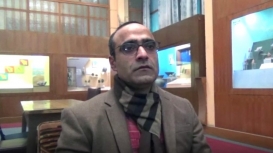The Kushana period in Kashmir is distinctively known for its terracotta art. The Valley, under the rule of Kushana kings, saw the rise of an independent school of art. Instead of stone, which was a popular material for the artists of Kushana period in the Indian subcontinent, especially those related to the Gandhara school of art, the artists of the Kushana period, in Kashmir, preferred clay as a medium for their artistic expression. This is attested by the large number of terracotta decorated tiles, mostly wedge-shaped, and terracotta figurines of humans and animals as well as terracotta beads, skin rubbers, seals and miscellaneous objects recovered from this region. These terracotta figurines bear Hellenistic influence and can be explored throughout the length and breadth of Kashmir. It should be noted here that the structures and pavements adhering to the diaper-pebble style of construction were decorated with terracotta tiles.This was an established feature in the patterning designs during the Kushana period, in and around the Kashmir Valley.
This module aims to document antiquities and artefacts, especially terracotta figurines, pertaining to the early historic period of Kashmir.


